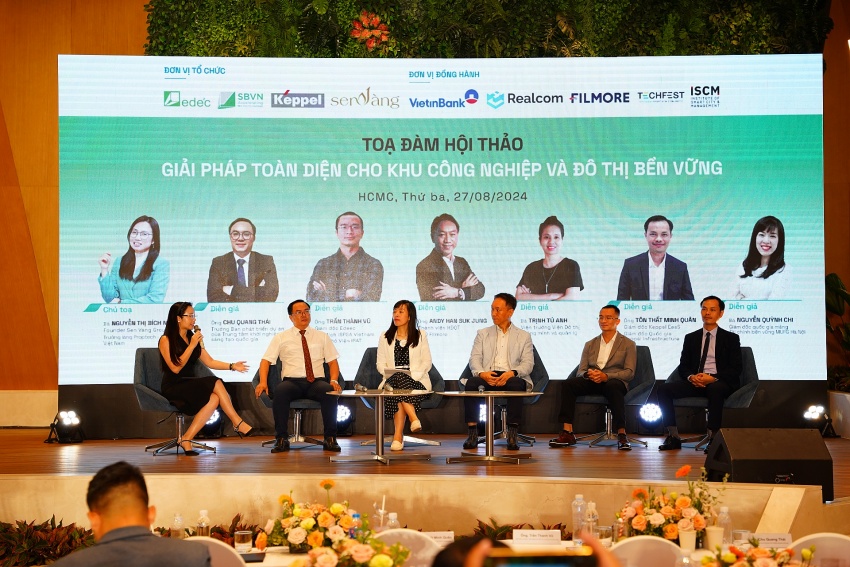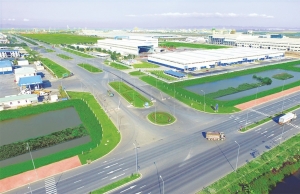More green buildings in Vietnam need to be realised
 |
| The round-table themed "Comprehensive solutions for sustainable industrial parks and urban areas" held in Ho Chi Minh City on August 27 |
Speaking at a conference themed "Comprehensive solutions for sustainable industrial parks and urban areas" held in Ho Chi Minh City on August 27, Tran Thanh Vu, director of Edeec Co., Ltd., said that Vietnam currently has about 300 green buildings, a number too small compared to the market size.
“We realise that green buildings in Vietnam are only green at the level of effort to obtain green certificates. Items closely related to actual emissions reductions, such as energy consumption over the life of a building, which accounts for 60-75 per cent of total emissions, are still a matter of chance. This is because the person who directly designs the buildings does not evaluate energy, and the person who evaluates the energy only performs a limited number of calculations," Vu said.
“This will be a solid foundation to move forward with energy balance projects. Then we can move on to net-zero energy low-rise buildings, and plan energy and amenities for high-rise buildings and calculate power offsets and carbon offsets,” he said.
Santanu Dutta Gupta, deputy director of the US Green Building Council, highlighted the latest trends in building and developing green industrial parks and urban areas around the world, and introduced evaluation standards to ensure sustainability and efficiency in environmental management.
“These standards help businesses optimise operating costs and contribute significantly to protecting natural resources, improving quality of life and promoting sustainable socioeconomic development efficiently,” he emphasised.
Le Phuong Anh, director of Sustainable Building Vietnam (SBVN), said that the net zero and CO2 emission reduction roadmap are both global goals.
SBVN is a programme jointly organised by the SBVN Social Organisation, the Institute of Sustainable Energy Settlement Research, and EDEEC – a leading technical consultant in green and energy-efficient construction in Vietnam. SBVN was established to promote sustainable construction in Vietnam and contribute to achieving the net zero goal by 2050.
Talking about strategies and sustainable development methods for businesses involved in industrial parks and urban area development, Nguyen Thi Bich Ngoc, founder of Sen Vang Group, shared that to achieve sustainability, businesses need to integrate green strategies into their development plans.
“This includes applying international standards for green construction, energy efficiency, and resource management optimisation,” said Ngoc.
She also shared practical methods to help businesses meet current development needs and ensure balance with the natural environment and surrounding communities.
According to Ngoc, to implement a green strategy, real estate businesses need to focus on important factors such as sustainable resource management, economical and renewable energy use, and eco-friendly design and construction.
“Currently, although implementing green commitments and achieving green certification is not mandatory, investors and project developers need to focus on green building development strategies. This strategy should be reflected in the core values of the business and expressed through practical commitment. In this way, implementing a green strategy and sustainable development will become a long value chain in the process of project development, creating competitive advantages and determining the development strategy of the enterprise,” she said.
After more than 15 years of development, Vietnam currently has over 300 green buildings with a total area of about 7.2 million square metres of construction floor.
 | Vietnam's 300 certified green buildings yet to reach net-zero As Vietnam intensifies its focus on sustainability, the nation's progress is spotlighted with a modest tally of 300 certified green buildings. To date, no building in Vietnam has been designed, constructed, or managed to meet net-zero criteria. |
 | Only world-class level can ensure truly green buildings Smart city development and building transition are vital to Vietnam’s booming economy on the green track. In addition to Vietnam’s rapid economic growth, urbanisation is taking place, increasing the demand for energy and building materials in cities such as Ho Chi Minh City and Hanoi. Therefore, energy-efficient and sustainable solutions play a central role on the way to Vietnam’s climate neutrality by 2050. |
 | Phuc Khang Corporation joins hands with Japanese businesses on green buildings Vietnamese entrepreneurs with a pioneering spirit should learn from experience and team up with foreign businesses to develop green buildings in Vietnam, helping to realise the government's net-zero commitment made at COP26. |
 | Ready-built factories aim for official green certifications Many ready-built factory developers are on track to develop green buildings meeting international standards. |
What the stars mean:
★ Poor ★ ★ Promising ★★★ Good ★★★★ Very good ★★★★★ Exceptional
Related Contents
Latest News
More News
- The Kross ascends in Ho Chi Minh City's business heart (October 10, 2025 | 17:16)
- ESG-driven sustainability to define Vietnam’s green real estate (September 19, 2025 | 11:35)
- Tan Thuan Tower open for high value-added and innovative tenants (September 10, 2025 | 10:00)
- The new home of modern business at Hanoi's Starlake (August 19, 2025 | 08:00)
- Forum focuses on financial solutions for ESG in real estate (June 18, 2025 | 12:12)
- Frasers Property Vietnam moves towards green real estate leadership (May 08, 2025 | 11:25)
- Keppel collaborates with leading brands to enhance urban living in Vietnam (April 04, 2025 | 09:26)
- Strengthen partnership and efforts to promote zero energy buildings in Vietnam (February 26, 2025 | 17:31)
- Haus Dalat ESG real estate project holds opening ceremony (February 24, 2025 | 11:12)
- Best golfers awarded at Swing for the Kids 2024 (October 13, 2024 | 08:00)

 Tag:
Tag:





















 Mobile Version
Mobile Version